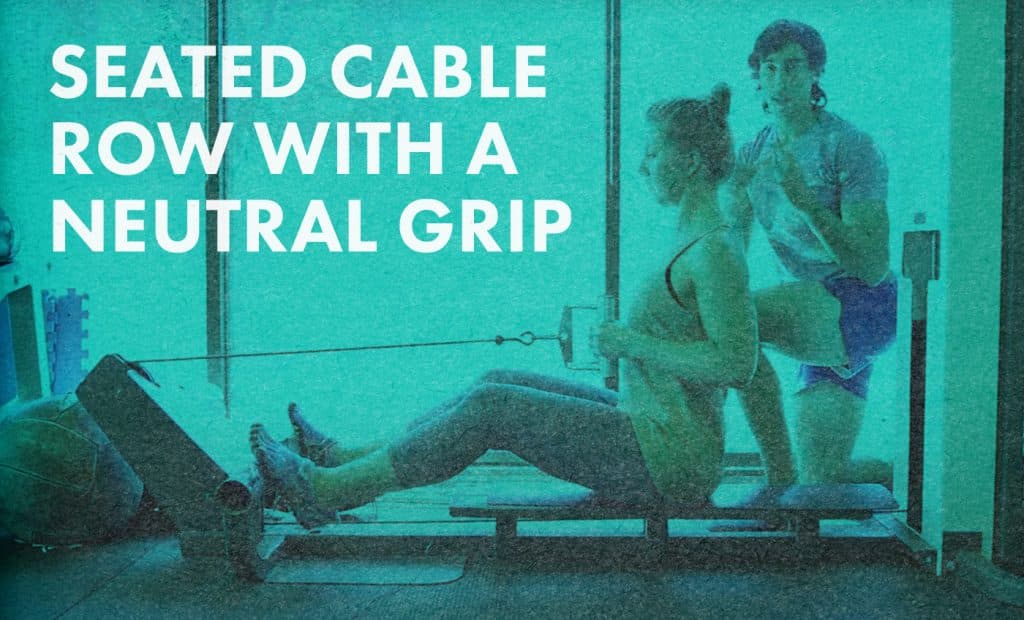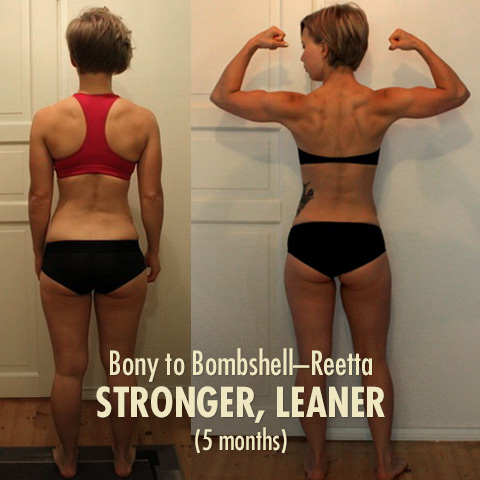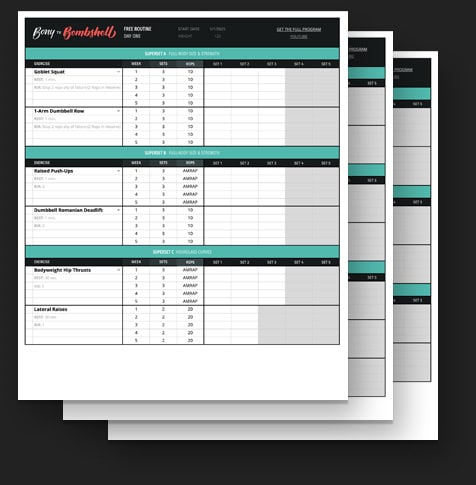
Seated Cable Row With Neutral Grip: Overview, How To Do It, & Tips
The seated cable row with a neutral grip is a great exercise for women who want to build some muscle in their back. You use a weighted cable machine that is set up horizontally with foot plates. Like other horizontal rowing variations, the main muscles it works are the lats, rhomboids, forearms, traps, and rear delts. It’s also fairly good for your arms, though, and should stimulate a bit of biceps growth. Let’s take a closer look at how to do this row variation, common mistakes, and how to program it into your workouts.
Seated Cable Row With Neutral Grip: The Overview
We use this rowing variation for our Bony to Bombshell program to get our members started. Using the cable is easy to set-up, can be used for simple progressive overload (adding weight) over time, and it’s a variation of rowing that beginners and long-time lifters can use.
Benefits
- Builds the back muscles. This exercise is primarily for your upper back but will also give your surrounding muscles a good amount of works. Don’t be surprised if your forearms or biceps get sore too.
- A simple variation that takes next to no time to set up, and that is easy to do. This exercise is great for beginners because it’s simple, stable, and just requires access to a cable rowing station and a simple v-shaped handle. (If you don’t have access to a cable machine, a good variation is the single-arm dumbbell row.)
- Helps to fill out the upper portion of the “hourglass curves.” Many women want wider hips, and we include plenty of lower body lifts. But if you’re a bit pear-shaped, you’ll want to include some upper body lifts in a feminine way to fill out the back and shoulders.
- Helps to develop upper body strength and independence. A lot of the women we work with want more strength to handle daily life. Whether that’s picking up a toddler or a heavy travel bag, lifting heavy groceries, or whatever else it is. The cable row can help to train those back muscles for helping when picking up heavy things in a safe way.

Muscles Worked
The cable row, like all rows, will primarily work the back, but it still works the shoulders and elbow joints and is a compound exercise. You might notice that even your fingers get a little sore from these ones.
- Lats. These muscles will be the star of this exercise and help the shoulders move and row the weight. They will help with your hourglass shape.
- Rhomboids. This is an upper back muscle, a bit closer to your spine and helps to stabilize and pull the shoulders back.
- Traps. These muscles run from the middle of your back and up your neck. They will help stabilize the weight and pull your shoulders back.
To a lesser extent, the seated cable row with a neutral grip will also work your biceps, rear delts (back of shoulders), forearms, and even your core muscles as your body works hard to stabilize against the dumbbell.
The neutral grip will allow you to hit more of the biceps compared to a pronated (overhand) grip, but less so compared to a supinated (underhand) grip. The neutral grip is a good, all-around position for balance, as it’s closest to how your arms would normally hang when next to your sides.
Seated Cable Row With Neutral Grip Video Demonstration
Here’s Marco coaching Marielle on how to do the seated cable row while keeping a neutral grip:
Seated Cable Row With A Neutral Grip Form Breakdown
- Go to the horizontal cable rowing station, and attach a handle that allows you to keep your thumbs pointing up.
- Move the pins on the weight plate to choose a weight appropriate for your strength levels.
- Sit down on the bench, close to the handle with your knees bent, and put your feet up against the plates.
- Reach down to the handle, sitting up straight, push against the plates to move your body away from your feet by straightening your legs a bit.
- You should now be feeling the tension of the cable stack being raised, and applying weight.
- Get into a neutral position where your back is in a straight line. This is your starting position.
- Take a deep breath, then breathe out as you contract with your back, rowing the weight, driving your elbows back, and bringing your thumbs to your armpit. You can push through your heels on the plate for power.
- At the end of the movement, take another breath in and slowly let the handle return back to the starting position, under control, as you breathe out.
- At the bottom of the movement (neutral position, you don’t need to bring the weight stack all the way back down), that completes the rep.
- Do the amount of reps listed on your workout sheet.
- Carefully bring the weight stack back down to it’s resting place, by bending your knees, and returning the weight back to it’s resting position.
- That’s one set.
Common Mistakes With The Seated Cable Row With A Neutral Grip
- Rowing with the whole body and not the back. Some people look like they’re out there rowing on the water and pushing with their legs, leaning too far forward, using the hips for momentum. This exercise is meant to isolate the back and to be under control. The goal is to work the back muscles, and you won’t be doing that with poor form.
- Choosing too heavy of a weight. If the weight is too heavy, you’ll have a hard time pulling the handle back all the way to your chest. You’ll find yourself jerking the weight and using other muscles in your body instead of controlling it. Lighten the weight and try again.
- Choosing too light of a weight. Many women underestimate their strength. If the reps feel too easy, try experimenting with going heavier and heavier until you can just barely do the reps listed on the sheet.
- Not breathing! Too many people hold their breath and bang out reps and wonder why they feel so lightheaded. At the very least, you should be doing a full breath in between reps. But we like to coach women to be breathing throughout the whole rep.
Using The Seated Cable Row With A Neutral Grip In A Female Workout
Use A Moderate Rep Range
In research, to optimize for muscle growth and muscle size, you want to choose a weight that you can do 4–40 repetitions with. The sweet spot for the cable rows is in the moderate rep range of around 8-12 reps. The reason why is because they’re a bit more isolated than other compound lifts. It’s easy to lift too heavy with these ones, and you end up not even targeting the right back muscles.
If you find yourself not able to do at least 7 reps, use a lighter weight. If you can do more than 12 repetitions, use a heavier weight. That will guarantee that the workout is helping you gain both muscle size and muscle strength and not making endurance adaptations.
Challenge Yourself, But Stop Shy Of Failure
Ideally, you’ll stop your seated cable rows when you’re just about to fail, but you could still do a couple of reps more. But if you’re a beginner, it’s hard to know exactly how hard you’re pushing yourself. Err on the side of lifting too light, and if it’s too light, count it as a warm-up. Keep working up, and you’ll know when the weight is right for your goal reps.
Make sure to never drop the weight! Failure means you can’t do any more rows, but that doesn’t mean you go until you lose your grip and let the weight stack slam. Always bend your knees and put the weights down properly.
Start With Two Sets, and Add More When Needed
Start with just a couple of sets, then over time, add more sets as you get stronger. We recommend doing two sets in the first week. Practice your form, find the right weights, and take your time learning the rowing motion.
Next week, if your back, biceps, and fingers aren’t too sore at the start of each workout, try adding a set to each exercise. If that goes well and you feel ready for more, add another set next week. You can do around 3–6 sets per exercise. Most women will do best with 3–4 sets. If you ever start to feel worn down, or if you’re coming back after a long break, start the cycle over again, going back to just two sets and rebuilding from there.
Rest 1-2 Minutes Between Sets
How long you rest between sets of cable rows isn’t that important. Whether you rest for 1 minute or 10 minutes, you’ll still stimulate a similar amount of growth. The important thing is that you rest long enough to catch your breath, ensuring that your cardiovascular system doesn’t limit the performance of your muscles.
We want to challenge your back muscles—not just your heart (though your heart will get a good workout, too!)
The main reason to rest for just a couple of minutes is to keep your workouts shorter. You don’t want to spend all day in the gym. But if you need more rest or get interrupted partway through your workout, no problem. Just pick up where you left off.
If you want to blast through your workout even faster, you can do the lifts in a circuit/superset. Do a set of cable rows, rest a minute, then do a set of dumbbell goblet squats next to the cable machine, rest a minute, then do your second set of cable rows, and then do your second set of goblet squats. That way, you’re still giving different muscle groups plenty of time to recover between sets, but you’re doing another exercise during the rest period.
Free Routine For Female Beginners: Full Body Workout That Includes The Seated Cable Row With A Neutral Grip
If you don’t have a workout, you might be interested in our full Bony to Bombshell program. A sample beginner’s workout for women that includes db sumo deadlifts could look like this:
- Goblet Squats: 2 sets of 10 repetitions.
- Dumbbell Sumo Deadlift: 2 sets of 10 repetitions.
- Raised Push-Ups: 2 sets of as many reps as you can.
- Seated Cable Rows With A Neutral Grip: 2 sets of 10 repetitions.
- Lateral Raises: 2 sets of 10 repetitions.
- Bonus Glute Work: 2 sets of glute bridges or hip thrusts
GET THE GOOGLE SPREADSHEET OF THE
FREE BEGINNER’S FULL-BODY WORKOUT For Women

Get the workout as a Google spreadsheet. You’ll be able to pick from exercise alternatives, fill out the sheet, and get our beginner’s warm-up.
Plus, we’ll make sure you’re on the Bony to Bombshell newsletter, and send you all of our best women's muscle-building content.
What Next?
If you liked this article, you’d love our muscle-building newsletter. We’ll keep you up to date on all the latest muscle-building information for women. Or, if you want us to walk you through the process of building muscle, including teaching you the lifts, giving you a full workout program, a complete diet guide, a recipe book, and online coaching, check out our Bony to Bombshell Program.



FREE women's Muscle Growth MINI-COURSE
Get our 5-part female bulking mini-course that covers everything you need to know about:
Here are some related articles